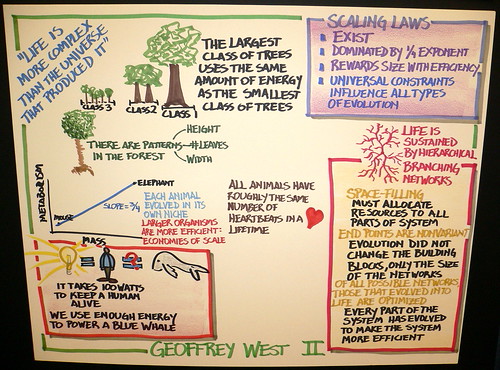The email sent will contain a link to this article, the article title, and an article excerpt (if available). For security reasons, your IP address will also be included in the sent email.
Hey, it's HighScalability time:

Freeman Dyson dissects Geoffrey West's book on universal scaling laws, Scale. (Image: Steve Jurvetson)
If you like this sort of Stuff then please support me on Patreon. And I'd appreciate if you would recommend my new book—Explain the Cloud Like I'm 10—to anyone who needs to understand the cloud (who doesn't?). I think they'll learn a lot, even if they're already familiar with the basics.
- 5x: BPF over iptables; 51.21%: SSL certificates now issued by Let's Encrypt; 15,000x: acceleration from a genomics co-processor on long read assembly; 100 Million: Amazon Prime members; 20 minutes: time it takes a robot to assemble an Ikea chair; 1.7 Tbps: DDoS Attack; 200 Gb/sec: future network fabric speeds; $7: average YouTube earnings per 1000 views; 800 million: viruses cascading onto every square meter of the planet each day; <10m: error in Uber's GPS enhancement; $45 million: total value of Bitcoin ransomware extortion;
- Quotable Quotes:
- @sachinrekhi: Excited to read the latest Amazon shareholder letter. Amazing the scale they are operating at: 100M prime members, $20B AWS business, >50% of products sold from third-party sellers...Bezos seems intent on stressing the economic value Amazon creates for so many, including "560,000 employees, 2 million sellers, hundreds of thousands of authors, millions of AWS developers, and hundreds of millions of divinely discontent customers around the world"...@JeffBezos and I share a belief that perks and benefits are not the best way to create a great culture. Instead high standards are: "people are drawn to high standards – they help with recruiting and retention."
- @kellabyte (good thread): We could really use a mature stable ring buffer implementation in #golang as an alternative to channels for high performance use cases. I need to pump hundreds of millions through a multi-producer single consumer data structure. Channels can’t keep up with that.
- @allspaw (good thread): Advocates of “error budgets” - please research past similar approaches to quantifying risk (probabilistic risk assessment (PRA) and human reliability analysis (HRA)). The limitations these methods have and illusions they produce are greater than you might think.
- @cloud_opinion: They [Google] are victims of internal politicking, currently container faction seems to be winning.
- @aprilwensel~ Last tweet reminds me… I really need to follow through on my project idea "April on Joel on Software," wherein I'll detail the various toxic beliefs spread by Joel Spolsky's articles and explain how they've contributed to the mess of a tech industry we have now...I'm mostly referring to his early 2000s posts relating to interviews and hiring and what makes a good engineer. Glorifying "smart" at the cost of being a decent person, reinforcing harmful stereotypes, promoting arrogance and elitism, etc. There are no doubt gems in there too. :)
- Murat: To motivate the importance of the cache hit rate research, Asaf mentioned the following. The key-value cache is 100x faster than database. For Facebook if you can improve its cache hit rate of 98%, by just another additional 1%, the performance would improve 35%.
- Jacob Richter: As a further step to reduce our costs, we are now running those models on the client side using TensorFlow.js instead of using an autoscaling EC2 container. While this was only a small change using the same code, it resulted in a proportionally massive cost reduction.
- @JeffDean: We just posted new DAWNBench results for ImageNet classification training time and cost using Google Cloud TPUs+AmoebaNet (architecture learned via evolutionary search). You can train a model to 93% top-5 accuracy in <7.5 hours for <$50.
- Packet Pushers: Businesses are forecast to spend $1.67 trillion on technology (hardware, software, and services) in 2018. Roughly half of that spending (50.5%) will come from the IT budget while the other half (49.5%) will come from the budgets of technology buyers outside of IT.
- There are so many more quotes...
Don't miss all that the Internet has to say on Scalability, click below and become eventually consistent with all scalability knowledge (which means this post has many more items to read so please keep on reading)...














 Return to Article
Return to Article